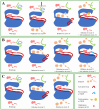Current Drug Resistance Mechanisms and Treatment Options in Gastrointestinal Stromal Tumors: Summary and Update
- PMID: 39441520
- PMCID: PMC11541409
- DOI: 10.1007/s11864-024-01272-7
Current Drug Resistance Mechanisms and Treatment Options in Gastrointestinal Stromal Tumors: Summary and Update
Abstract
Gastrointestinal stromal tumor (GIST) is characterized by well-defined oncogenes. Despite the significant improvement in treatment outcomes with adjuvant imatinib therapy for patients, drug resistance remains a major challenge for GIST therapy. This review focuses on the mechanisms contributing to drug resistance phenotype in GIST, such as primary imatinib-resistant mutants, secondary mutations, non-covalent binding of TKI to its target, tumor heterogeneity, re-activation of pro-survival/proliferation pathways through non-KIT/PDGFRA kinases, and loss of therapeutic targets in wild-type GIST. Corresponding suggestions are proposed to overcome drug-resistance phenotype of GIST. This review also summarizes the suitability of currently approved TKIs on different KIT/PDGFRA mutations and updates related clinical trials. Recent potent drugs and emerging strategies against advanced GISTs in clinical trials are presented. Additionally, metabolic intervention offers a new avenue for clinical management in GIST. A landscape of metabolism in GIST and metabolic changes under imatinib treatment are summarized based on currently published data. The OXPHOS pathway is a promising therapeutic target in combination with TKI against sensitive KIT/PDGFRA mutants. Comprehensive understanding of the above resistance mechanisms, experimental drugs/strategies and metabolic changes is critical to implement the proper therapy strategy and improve the clinical therapy outcomes for GIST.
Keywords: Drug resistance; GIST; Imatinib; Metabolism; Tyrosine kinase inhibitor.
© 2024. The Author(s).
Conflict of interest statement
The authors declare no competing interests.
The authors declare no competing interests.
Figures




Similar articles
-
[The importance of mutational status in prognosis and therapy of GIST].Recenti Prog Med. 2015 Jan;106(1):17-22. doi: 10.1701/1740.18950. Recenti Prog Med. 2015. PMID: 25621775 Italian.
-
Identifying Secondary Mutations in Chinese Patients with Imatinib-Resistant Gastrointestinal Stromal Tumors (GISTs) by Next Generation Sequencing (NGS).Pathol Oncol Res. 2020 Jan;26(1):91-100. doi: 10.1007/s12253-019-00770-6. Epub 2019 Nov 22. Pathol Oncol Res. 2020. PMID: 31758409
-
Ripretinib for the treatment of advanced, imatinib-resistant gastrointestinal stromal tumors.J Dig Dis. 2024 Sep-Oct;25(9-10):559-563. doi: 10.1111/1751-2980.13229. Epub 2023 Oct 19. J Dig Dis. 2024. PMID: 37706279 Free PMC article. Review.
-
Tyrosine kinase inhibitors in the treatment of unresectable or metastatic gastrointestinal stromal tumors.Expert Opin Pharmacother. 2014 Oct;15(14):1979-89. doi: 10.1517/14656566.2014.937707. Epub 2014 Jul 3. Expert Opin Pharmacother. 2014. PMID: 24990162 Review.
-
A Novel Receptor Tyrosine Kinase Switch Promotes Gastrointestinal Stromal Tumor Drug Resistance.Molecules. 2017 Dec 5;22(12):2152. doi: 10.3390/molecules22122152. Molecules. 2017. PMID: 29206199 Free PMC article.
Cited by
-
Role of SMYD2 in gastrointestinal cancer progression (Review).Oncol Lett. 2025 Apr 8;29(6):282. doi: 10.3892/ol.2025.15028. eCollection 2025 Jun. Oncol Lett. 2025. PMID: 40242267 Free PMC article. Review.
-
Characteristics and clinical outcomes of early-onset gastrointestinal stromal tumors: a population‑based study.Transl Cancer Res. 2025 Apr 30;14(4):2220-2232. doi: 10.21037/tcr-24-1942. Epub 2025 Apr 22. Transl Cancer Res. 2025. PMID: 40386266 Free PMC article.
-
MicroRNAs as Sensitizers of Tyrosine Kinase Inhibitor Resistance in Cancer: Small Molecule Partnerships.Pharmaceuticals (Basel). 2025 Mar 28;18(4):492. doi: 10.3390/ph18040492. Pharmaceuticals (Basel). 2025. PMID: 40283927 Free PMC article. Review.
-
SHP2 inhibition and adjuvant therapy synergistically target KIT-mutant GISTs via ERK1/2-regulated GSK3β/cyclin D1 pathway.Clin Transl Med. 2025 Feb;15(2):e70231. doi: 10.1002/ctm2.70231. Clin Transl Med. 2025. PMID: 39981588 Free PMC article.
References
-
- Fletcher CDM, et al. Diagnosis of gastrointestinal stromal tumors: A consensus approach. Hum Pathol. 2002;33(5):459–65. - PubMed
-
- Heinrich MC, et al. PDGFRA activating mutations in gastrointestinal stromal tumors. Science. 2003;299(5607):708–10. - PubMed
-
- Hirota S, et al. Gain-of-function mutations of c-kit in human gastrointestinal stromal tumors. Science. 1998;279(5350):577–80. - PubMed
Publication types
MeSH terms
Substances
Grants and funding
LinkOut - more resources
Full Text Sources
Miscellaneous

